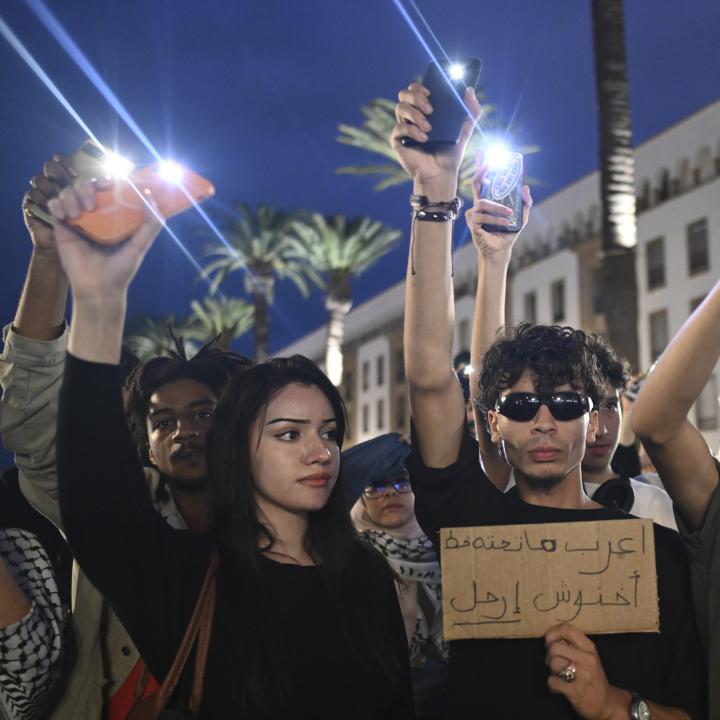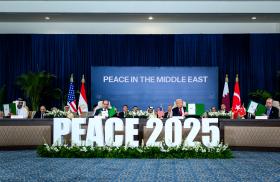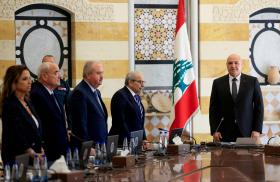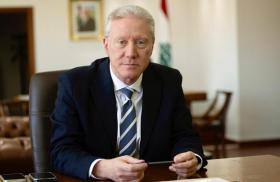
- Policy Analysis
- PolicyWatch 4119
From Discord to the Streets: Gen Z’s Moment in the Middle East

Facing an uncertain economic future and fed up with corruption and mismanagement, young people in countries from Morocco to Iran have begun voicing demands for more responsive leadership and a more open society.
The skull-and-crossbones Jolly Roger flag with a straw hat—popularized by the Japanese anime series One Piece—is waving in the wind at protests across Morocco. The image has become a rallying symbol for Gen Z Moroccans, who have led protests in cities and suburbs across the country since September 27. The choice of a story about a pirate fighting elites and oppression reflects the global connectivity of Gen Z, but it also points to the systemic grievances driving youth into the streets in places like Madagascar, Nepal, Peru, the Philippines, and South Africa—as well as Iran in 2022.
Character of Morocco’s Gen Z Protests
Known as Gen Z 212—in reference to Morocco’s country code—the protests began in response to a series of deaths among pregnant women in the main public hospital in the southern city of Agadir. The leaderless movement then spread to at least twenty other cities and towns, including Casablanca, Marrakesh, Oujda, Rabat, and Tangier. (Another pregnant woman died at the same Agadir hospital on October 7). Social media tools, including the video app TikTok and gamer app Discord, have facilitated its spread via the hashtag #GenZ212. These are the largest protests in Morocco since the 2011 Arab Spring, when the February 20 Movement formed amid uprisings elsewhere in Arab countries that drew on social media and focused on dignity, justice, and freedom—thereafter toppling governments in countries including Tunisia, Egypt, and Libya.
The 2030 FIFA World Cup is at the center of Moroccan Gen Z-er frustrations. In 2023, Morocco was selected to co-host the event with Spain and Portugal. The billions of U.S. dollars spent on tourism and new stadiums—including the Moulay Abdellah complex in Rabat, which was completed in mid-September—have sparked an outcry, with protesters chanting, “We have stadiums, but what about our hospitals?” Despite moving toward universal healthcare coverage—as guaranteed by the 2011 constitution—citizens particularly in rural areas complain of poor-quality services and high out-of-pocket costs. According to the Statista healthcare index, Morocco’s system ranks at the bottom globally, below neighboring Algeria and Tunisia.
“Freedom, dignity, and social justice”—a slogan popularized in 2011—has also reemerged in the current scene. More than half of Morocco’s population, reflecting demographics in the broader region, is younger than thirty-five. Youth unemployment—although having declined over the past decade, COVID effects notwithstanding—is at a steep 22.1 percent. According to a June 2025 report by Afrobarometer, 28 percent of the Moroccan youth population—up 8 percent from 2017—would prefer to emigrate than stay home, due to limited opportunities.
These grievances are not new, but since a protest movement in 2016, the most recent until now, Morocco has increasingly sought to position itself as a strategic partner for countries across the globe. That year, Morocco entered into a strategic partnership with China, facilitating projects such as the high-speed railway between Kenitra and Marrakesh, an approach some argue does not make economic sense given the country’s high rates of unemployment and relative poverty. In 2017, Morocco rejoined the African Union—having left in objection to the Union’s inclusion of the Sahrawi Arab Democratic Republic—leading to increased outreach across the continent and developments such as Casablanca Finance City, a regional hub for financial institutions. Such efforts were conducted in effective preparation for the 2030 World Cup, when the kingdom could showcase its flashy new roads and stadiums for international audiences.
A seemingly fearless Gen Z underscores how a new generation of Moroccans—as elsewhere around the region—is speaking out against continuing injustices and systemic problems that plague their respective countries. The larger trend of youth protests around the world suggests that other countries in the Middle East could be next. Calls for similar protests in neighboring Algeria have already reportedly begun.
Why Is Gen Z Angry?
The cohort born between roughly 1997 and 2012 can be regarded as the first truly globalized generation, having been raised with the internet and social media at their fingertips. They have also lived under burdens like the 2008–9 global financial crisis and—about a decade later—the pandemic, both of which have limited their economic opportunities. Across the developing world, corruption, inequality, and mismanagement have only laid more obstacles in their path.
As a result, members of Gen Z face a shared set of systemic challenges. Many feel they have no control over their future and are disappointed by what previous generations—particularly baby boomers—have left them. Alongside corruption and mismanagement, they confront a world of rising inflation and seemingly existential threats posed by climate change and artificial intelligence.
Gen Z’s hyperconnectivity also explains why a Manga series like One Piece can resonate across borders, and why members dress in the same oversize clothing, use the same slang, participate in the same viral TikTok dances, and shop for the same Labubu dolls in bazaars from Cairo to Tehran.
A commonality of spirit stretching across the “global south” also characterized Iran’s Woman, Life, Freedom protests in 2022, which were prompted by the murder of twenty-two-year-old Mahsa Amini by the so-called morality police. Although they have not yet succeeded in their push to oust the clerical establishment, Gen Z Iranians were among the first of their generation to rise up against systemic problems: corruption, mismanagement, and repression. It is no surprise, then, that the Islamic Republic views them as a force to be reckoned with—as underscored by President Masoud Pezeshkian’s recent decision to appoint a Gen Z advisor to his cabinet.
How Rabat Might Respond
King Mohammed VI has yet to respond to the protests, but he is expected to mention them in an address to parliament on October 10. Nonetheless, criticism of the monarchy remains taboo. Protesters have generally gone easy on the monarch, both enjoining (“The people want the king to intervene”) and flattering him (“Long live the king”). They have instead directed their ire at figures such as Prime Minister Aziz Akhannouch, who has been accused of corruption—and just so happens to be one of the wealthiest men in the country. All the same, his party, the National Rally of Independents, is closely aligned with the palace. Even as protesters have paused their demonstrations in advance of the king’s speech, they have indicated they will soon resume their campaign for change.
The government has responded by calling for dialogue with the protesters, but it has simultaneously appeared to authorize a harsh response by security forces, resulting in hundreds of injuries and thousands of arrests, according to the Ministry of Interior—along with the killing by police of three protesters who reportedly stormed a station near Agadir. Meanwhile, even as messaging on Discord has advocated nonviolence and cleanup efforts following acts of vandalism, looting has still occurred in various cities. Seen through this lens, vulnerabilities for the Gen Z 212 movement include its leaderless nature, informal organization, and spontaneity. While these traits preserve an aura of independence, the complete absence of an organizational structure could allow authorities to exploit inevitable internal divisions and potentially establish effective control over the movement.
Instead of turning to the oft-ailing king for action, some protesters are looking to Crown Prince Moulay Hassan, a Gen Z-er born in 2003 who has made increasing public appearances of late. Like the Hashemite Kingdom of Jordan, which has been giving its millennial Crown Prince Hussein a more front-facing role and is also struggling with the economy and a discontented populace, the Moroccan leadership is likely searching for ways to demonstrate attentiveness to the country’s youth.
Policy Implications
Because of its deep, longstanding relationship with Morocco, the United States should closely monitor the kingdom’s stability and continually assess whether disgruntlement with the leadership has morphed into disgruntlement with the United States—especially given Moroccans’ general outspokenness against Israel’s war in Gaza. Washington should similarly monitor potential social unrest in other Middle East and North African countries. Supposedly stable monarchies such as Jordan risk seeing like-minded movements in which young people—angry over similar injustices and the Gaza war—could take to the streets. Morocco’s Gen Z protests have until now displayed caution and nonviolent intent. Nonetheless, events during the past two weeks suggest that while history may not repeat itself (in the form of a 2011-style uprising), it often does rhyme.
Holly Dagres is the Libitzky Family Senior Fellow in The Washington Institute’s Viterbi Program on Iran and U.S. Policy. Sabina Henneberg is a senior fellow at the Institute and director of its Junior Research Program.




